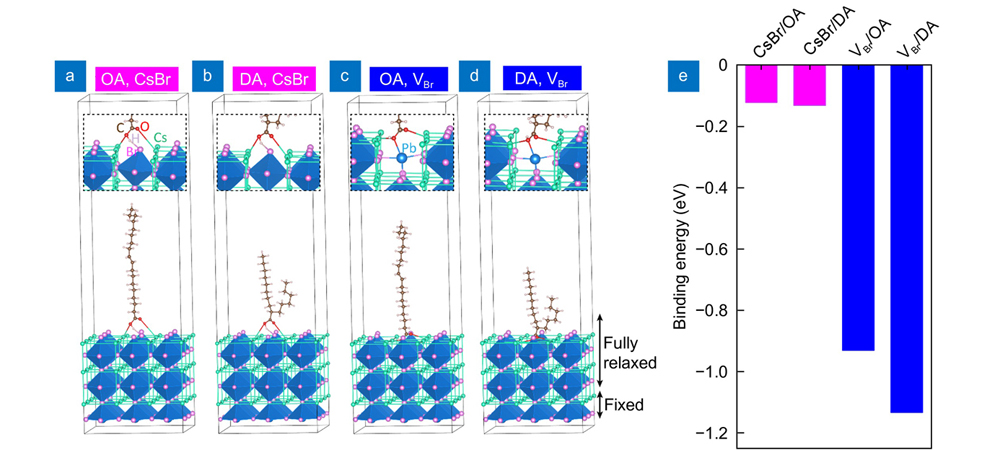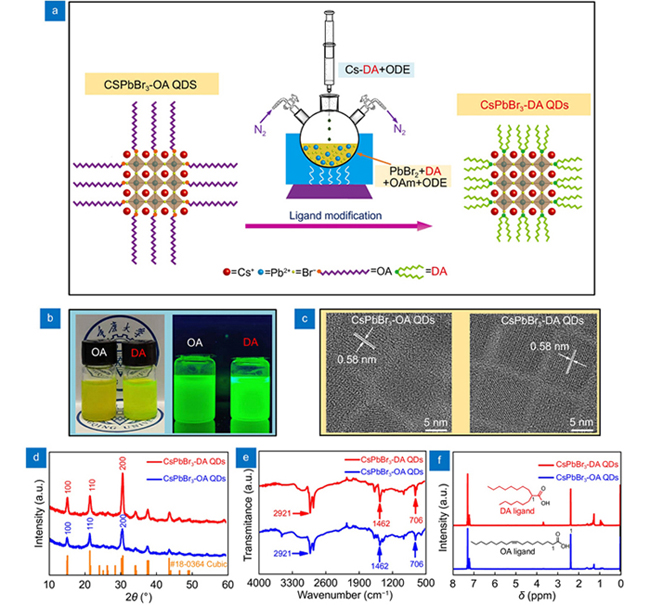Dongdong Yan, Shuangyi Zhao, Yubo Zhang, Huaxin Wang, Zhigang Zang. Highly efficient emission and high-CRI warm white light-emitting diodes from ligand-modified CsPbBr3 quantum dots[J]. Opto-Electronic Advances, 2022, 5(1): 200075
Search by keywords or author
- Opto-Electronic Advances
- Vol. 5, Issue 1, 200075 (2022)

Fig. 1. Relaxed surface models for simulating the adsorption of OA/DA molecules on the CsPbBr3 surface. The insets are the zoomed-in plot of the bonded regions. (a ) OA on top of the pristine CsBr-terminated surface. (b ) DA on top of the pristine CsBr-terminated surface. (c ) OA bonding with a Br-vacancy. (d ) DA bonding with a Br-vacancy. (e ) The binding energies of the four interfaces.

Fig. 2. (a ) The schematic illustration of the surface in the CsPbBr3 QDs with ligand modification process. (b ) Photographs of the CsPbBr3 QDs solution under the daylight (left) and UV light of 365 nm (right). (c ) HRTEM images. (d ) XRD patterns. (e ) FTIR spectra. (f )1H-NMR spectra after washed twice.
Fig. 3. (a ) PL spectra. (b ) Absorption spectra. (c ) PL decays and (d , e ) AFM images of the QDs films.
Fig. 4. CsPbBr3-OA QDs and CsPbBr3-DA QDs in ethanol. (a ) Photographs. (b , c ) PL spectra. (d ) PL intensity variation of QDs solutions over 90 min.
Fig. 5. Photographs of CsPbBr3 QDs solution under daylight and UV light of 365 nm.
Fig. 6. (a ) PL spectrum of WLEDs based on CsPbBr3-OA QDs with a CRI of 82. (b ) PL spectrum of WLEDs based on CsPbBr3-DA QDs with a CRI of 93 (The inset shows photographs of the devices without and with driving voltage). (c ) CIE chromaticity diagram of both WLEDs.
Fig. 7. The thermal imaging photographs of (a ) CsPbBr3-OA QDs WLEDs and (b ) CsPbBr3-DA QDs WLEDs with various driving current.
|
Table 0. Comparison of the main optical parameters in WLEDs based on CsPbBr3 QDs.
|
Table 0. Optical parameters of WLEDs based on CsPbBr3 QDs.

Set citation alerts for the article
Please enter your email address



